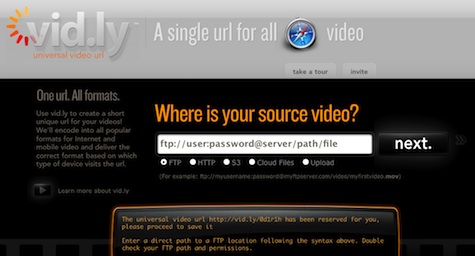-
Vid.ly Makes Sharing Videos To Mobile Devices a Snap
If you've ever sent one of your "must see" video clips around to friends or family, only to have them exasperatingly tell you "It didn't play for me!" when they tried accessing it on their mobile device, then a clever new service called Vid.ly is going to make you smile. Vid.ly's mission is to radically simplify the video transcoding and playback process so that virtually all mobile devices or browsers can play any video - regardless of their original format. Given the confusing proliferation of formats - Flash, WebM, HTML5, etc. and devices (iOS, Android, Blackberry, game consoles, etc.) that is a significant value proposition.
Vid.ly's special appeal to consumers is that it puts a familiar URL-shortening, social media-friendly front-end on Encoding.com's cloud-based transcoding capability, which has been battle tested by 1,000+ content providers to date. But whereas URL shorteners like Bit.ly primarily focus on making very long URLs shorter and therefore more manageable for social media use, Vid.ly actually addresses the underlying playability of the video and also provides a short URL.
As Jeff Malkin, Encoding.com's president told me last week, simplicity was Vid.ly's driving goal. Rather than exposing any technical complexity, with Vid.ly you just choose where you want to upload your file from (your hard drive, cloud storage, FTP, etc.), click "Finish" and then stand by for Vid.ly to transcode into 14 different video/audio combinations that will satisfy most of today's devices and browsers. Your Vid.ly URL is exposed and ready for publishing, as is embed code that you can grab to insert in web pages. When users try to access the Vid.ly URL, their device is auto-detected and the appropriately formatted video is delivered.
I gave Vid.ly a whirl with a 2 minute video I captured on my Flip video camera, which I'd transferred to iPhoto on my MacBook. The Vid.ly upload/transcode process took about 15-20 minutes and a scrolling window discloses what Vid.ly is doing with the video file each step of the way. Some of the update messages are straightforward, while some include small doses of humor, such as "Creating a FLV version of your video great for archaic browsers like IE."
I received an email when my URL was ready and sure enough, the video played back nicely on my iPad, my Droid X, and my wife's BlackBerry. (As a side note, a couple of week's ago I mentioned that I'd been stymied transferring the same Flip video from my MacBook to my iPad. At the Apple store I learned that's because the iPad doesn't play Flip's video format, and therefore I'd have to download video conversion software to make it work. There's a textbook example for why Vid.ly is needed!)
As powerful as Vid.ly's no-fuss, no-muss approach is for consumers who want to share their videos with one another, it will be even more appealing to content providers who want to easily transcode an infinite number of their videos for playback on all sorts of devices. With Vid.ly's "Pro" version, set for release in 8-12 weeks, content providers will be able to integrate a Vid.ly API into their work flow, so that the transcoding happens automatically each time. The Pro version will also support adaptive bit rate streaming (a requirement for video-based apps to gain Apple's approval), the ability to customize the 14 profiles, unlimited choice of CDNs, and no source file restrictions. Since Vid.ly will be free to users (for files up to 1GB in size), Vid.ly Pro is the main business model.
Vid.ly, which begins a private beta today, will be fully released in 3-4 weeks depending on how the beta goes. Pricing information for Vid.ly Pro hasn't yet been made available.
What do you think? Post a comment now (no sign-in required).Categories: Devices, Encoding, Mobile Video
Topics: Encoding.com, Vid.ly


